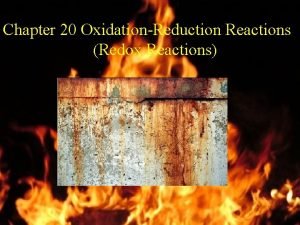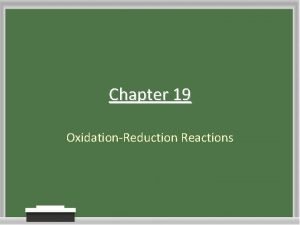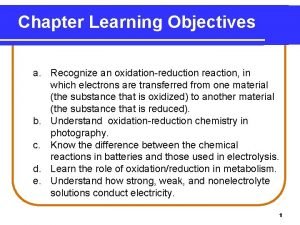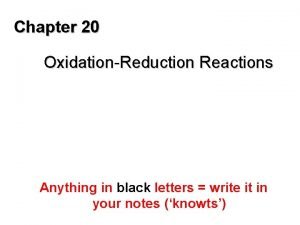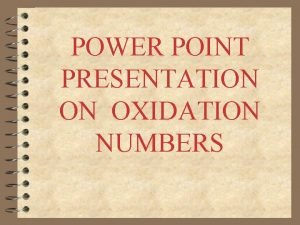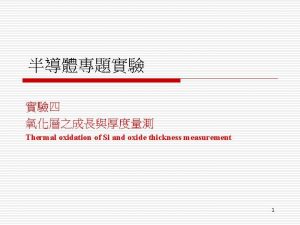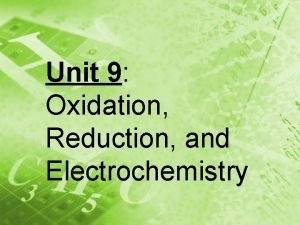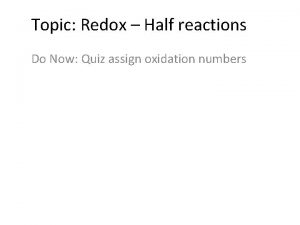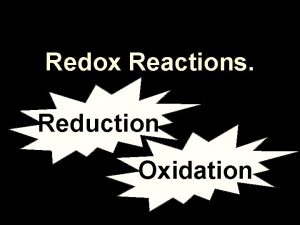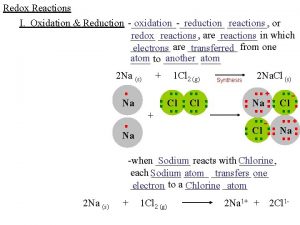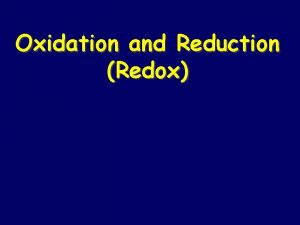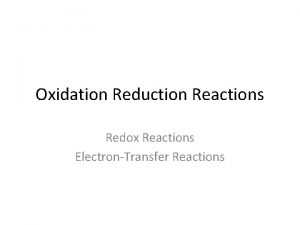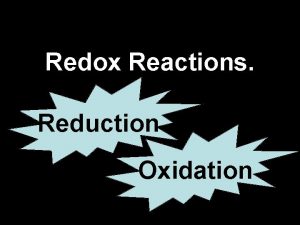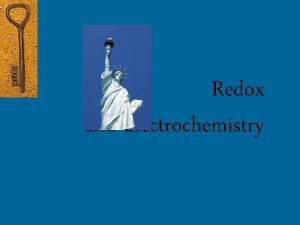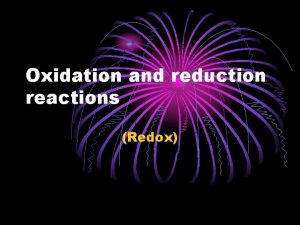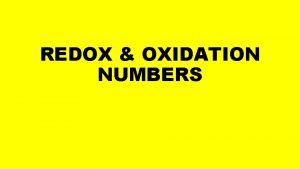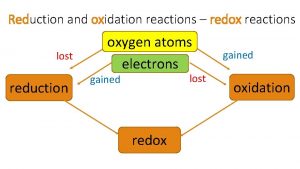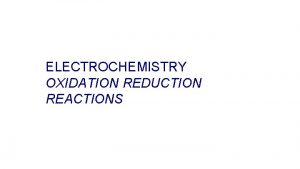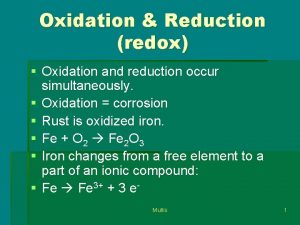Section 4 4 Oxidation Reduction Reactions Redox Reactions















- Slides: 15

Section 4. 4 Oxidation Reduction Reactions Redox Reactions Electron-Transfer Reactions

In this section: a. b. c. d. oxidation and reduction oxidation numbers recognizing redox reactions predicting redox reactions Not from this section: a. Organic reactions

Oxidation-Reduction Reactions Oxidation = loss of electrons Reduction = gain of electrons Zn(s) + Cu 2+(aq) Zn 2+(aq) + Cu(s) Oxidation Half-Reaction: Zn(s) Zn 2+(aq) + 2 e- Reduction Half-Reaction: Cu 2+(aq) + 2 e- Cu(s)

Oxidation-Reduction Reactions Oxidation = loss of electrons Reduction = gain of electrons Zn(s) + Cu 2+(aq) Zn 2+(aq) + Cu(s) Oxidizing agent = oxidant = gains electrons Reducing agent = reductant = loses electrons

Balancing Simple Redox Reactions Cu(s) + Ag+(aq) Cu 2+(aq) + 2 Ag(s)

Oxidation Numbers Electron tracking method. Oxidation numbers do not imply charges.


Examples: N in N 2 Fe in Fe 3+ N in NO 2 O in H 2 O Cl in Na. OCl Mn in Mn. O 4 -

Recognizing Oxidation-Reduction Reactions Oxidation = loss of electrons = increase in ox # Reduction = gain of electrons = decrease in ox # 4 Fe + 3 O 2 2 Fe 2 O 3

Cu. O(s) + H 2(g) Cu(s) + H 2 O( ) Ca. CO 3(s) Ca. O(s) + CO 2(g)

Mn. O 4 -(aq) + 5 Fe 2+(aq) + 8 H+(aq) Mn 2+(aq) + 4 H 2 O( ) + 5 Fe 3+(aq)

Predicting Redox Reactions

Organic Reactions A. Combustion Reactions Reaction with oxygen gas to form CO 2 and H 2 O. C 3 H 8(g) + 5 O 2(g) 3 CO 2(g) + 4 H 2 O(l) B. Substitution Reactions Exchange of one atom or molecular fragment.

C. Addition Reactions Addition of two molecules together. D. Elimination Reactions Ejection of a small molecule from a larger one.

E. Isomerization (Rearrangement) Reactions Change of shape of a molecule without gain or loss of any atoms.
 Chapter 19 review oxidation-reduction reactions
Chapter 19 review oxidation-reduction reactions Chapter 20 oxidation-reduction reactions answer key
Chapter 20 oxidation-reduction reactions answer key What are redox reactions
What are redox reactions Log sig fig
Log sig fig Chapter 19 review oxidation-reduction reactions answers
Chapter 19 review oxidation-reduction reactions answers Oxidation–reduction reactions
Oxidation–reduction reactions Leo the lion says ger
Leo the lion says ger What is redox reaction
What is redox reaction Oxidation
Oxidation What are redox reactions examples
What are redox reactions examples Dry oxidation vs wet oxidation
Dry oxidation vs wet oxidation Section 2 classifying chemical reactions
Section 2 classifying chemical reactions Section 2 classifying chemical reactions
Section 2 classifying chemical reactions Types of reactions
Types of reactions Which equation represents an oxidation-reduction reaction
Which equation represents an oxidation-reduction reaction Oxidation reduction quiz
Oxidation reduction quiz

